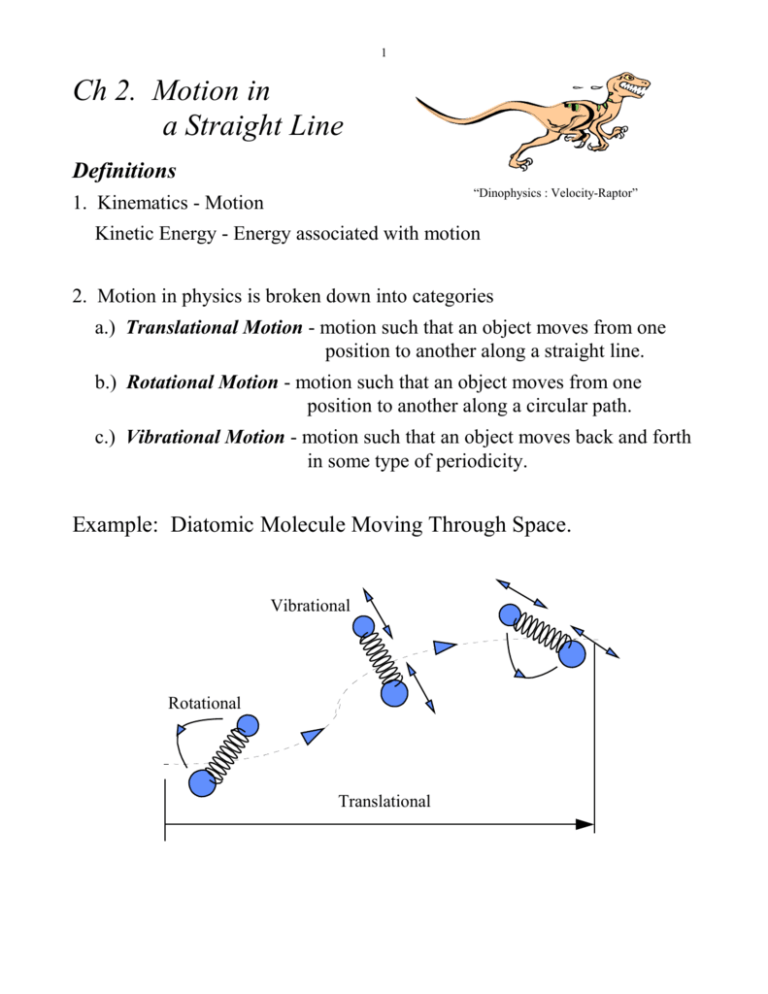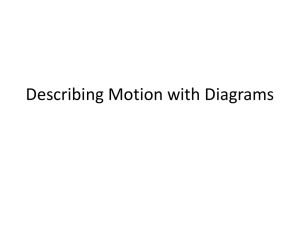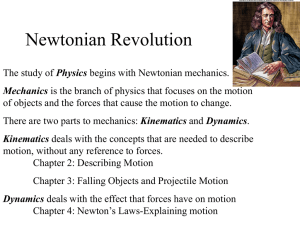Ch 2 One Dimensional Motion
advertisement

1 Ch 2. Motion in a Straight Line Definitions “Dinophysics : Velocity-Raptor” 1. Kinematics - Motion Kinetic Energy - Energy associated with motion 2. Motion in physics is broken down into categories a.) Translational Motion - motion such that an object moves from one position to another along a straight line. b.) Rotational Motion - motion such that an object moves from one position to another along a circular path. c.) Vibrational Motion - motion such that an object moves back and forth in some type of periodicity. Example: Diatomic Molecule Moving Through Space. Vibrational Rotational Translational 2 Speed 1. Speed - How fast an object is moving regardless of what direction it is moving. Speed = Distance Traveled Change in time Example 1. Traveling from your parking space at Conestoga to New York City and back to Conestoga. Find your avg. speed. y(mi) One way travel = 130 mi. back Total Distance Traveled = 260 mi. Total time elapsed = 5.2 hrs. or (5 hrs 12 min) NY up Conestoga x(mi) 3 Average Velocity and Displacement Displacement - Change in position (straight line distance with direction) Must specify a coordinate system. Example: Cartesian coordinate system y(m) xi = xinitial= Initial Position xf = xfinal = Final Position “Delta” xi= 2m xf= 6m x1 x2 x(m) Gives the direction x = Change in x = x x 6 m- 2 m = + 4 m x f i Delta x is the displacement Avg. Velocity - How fast an object is moving and in what direction it is moving. Average Velocity = Change in position Change in time x xf xi Average Velocity = t t f t i 4 Notation for Displacement & Vel. Example Problem x = x “hat”, and has a value of one. The sole purpose of x is to indicate the direction Example Problem: A particle initially at position x = 5 m at time t= 2 s moves to position x = -2 m and arrives at time t = 4 s. a.) Find the displacement of the particle. b.) Find the average speed and velocity of the particle. y(m) x(m) 5 Example Problem 1 revisited Example 1. Traveling from your parking space at Conestoga to New York City and back to Conestoga. The straight line distance from Conestoga to Y is 97 mi. y(mi) back One way travel = 130 mi. NY Total Distance Traveled = 260 mi. Travel time Con. to NY = 2.6 hrs. Travel time NY to Con. = 2.6 hrs. up 0 Conestoga 97 x(mi) a.) What was the avg. speed from Conestoga to NY? b.) What was the avg. velocity from Conestoga to NY? c.) What was the avg. speed for the round trip? d.) What was the avg. velocity for the round trip? Note: Speed in PATH DEPENDENT Velocity is PATH INDEPENDENT. It only depends on the initial and final positions. 6 Scalar vs. Vector Quantities Scalar - Quantity that has magnitude only. - Mass - Speed - Length - Energy Vector - A quantity that has both magnitude and direction. - Position - Acceleration - Velocity - Forces Example: Length vs. Position Pt. B Pt. A -6 -5 -4 -3 -2 -1 0 1 2 3 4 5 6 x(m) As measured from the origin the length to pt. A is 3m. To specify the Pt. A in space you must reference it to the origin and then Pt. A = + (3 m) x or, the Position Vector A = + (3 m) x x = x “hat”, and is called a unit vector in the x-direction. It has a magnitude of one (hence the name unit) and is used solely to specify direction. 7 Position vs Time Graph x Time (s) 0 1 2 3 4 5 Y1 Position (m) 0 1 4 9 16 25 Y2 Position (m) 0 5 10 15 20 25 Position (m) (x-coord.) Position vs. Time 30 25 20 Movement 2 15 10 Movement 1 5 0 0 1 2 3 Time (sec) 4 5 6 8 Position vs. Time Graph for a Complete Trip 300 250 B C Position (m) 200 D 150 100 50 F A 0 -50 -100 E -150 0 x Time (s) 0 10 20 25 45 60 y Position (m) 0 200 200 150 -100 0 10 20 30 Time (s) 40 50 60 Find the average velocity as the object moves from: a.) A to B b.) B to C c.) C to D. d.) A to E 9 Velocity vs. Time (Constant Velocity) Position Function t 8 7 x(m) 6 5 4 x 3 2 1 0 0 1 2 3 4 5 t(sec) v ave x Area! t Velocity Function 4 v (m/s) 3 2 x 1 0 0 1 2 3 t(sec) 4 5 10 Velocity vs. Time Graph for a Complete Trip 300 250 B C Position (m) 200 D 150 100 50 F A 0 -50 -100 E -150 0 10 20 30 Time (s) 40 50 60 25 20 A B Velocity (m/s) 15 10 E F 5 B 0 C -5 -10 C D E D -15 -20 -25 0 10 20 30 Time (s) 40 50 60 11 Instantaneous Velocity Recall: vavg x x t f x t i xˆ (Average velocity) t tf ti m 2 m 4 x t 3 m + 10 t - 0.5 4 t 2 s s Consider the function x(t): A. v avg 50.5 m-35.0 m m 10.3 xˆ 3.5 s - 2.0 s s 2 s < t < 3.5 s t = 1.5 sec B. vavg 39.7 m-35.0 m m 23.5 xˆ 2.2 s - 2.0 s s 2 s < t < 2.2 s t = 0.2 sec 60 slope = 10.3m/s 50 50 40 x(m) 40 x(m) slope = 23.5 m/s 60 30 30 20 20 10 10 0 0 0 1 2 3 4 0 t(sec) 1 2 3 t(sec) A. B. t (sec) vave (m/s) 1 0.2 0.01 0.001 17.5 23.45 23.98 23.998 Define: The instantaneous velocity at time ti is the slope of the line tangent to the curve X(t) at the time ti. 4 12 The instantaneous velocity at the time t = ti is the limiting value we get by letting the upper value of the tf approach ti. Mathematically this is expressed as: X t f X t i dX t v t lim dt t f ti t f ti The velocity function vt is the time derivative of the position function X t . Differentiation (Calculus) 13 Acceleration When the instantaneous velocity of a particle is changing with time, the particle is accelerating v v v aavg f i xˆ t tf ti (Average Acceleration) Units: a avg m/s m s 2 s Example: If a particle is moving with a velocity in the x-direction given by m v(t) 3 3 t 2 s a.) What is the average acceleration over the time interval 6 s t 12 s 14 Example: Instantaneous Acceleration time (s) vel. (m/s) Velocity vs. Time 0 1 2 3 4 5 6 7 8 35 30 velocity (m/s) 25 20 15 10 5 0 -5 -10 -2 -5 5 12 14 12 21 30 -10 -15 0 2 4 6 8 10 3 t 6 time (s) a.) Find aavg. over the time interval 5 t 8 b.) What is the acceleration at time t = 6 s ? c.) What is the acceleration when the velocity of the particle is zero? 15 Positive and Negative Accelerations v(m/s) C B A A→B: B→C: C→D: D→E: E→F: D E t (s) F 16 Special Case: Constant Acceleration We make the assumption that the acceleration does not change. Near the surface of the earth, (where most of us spend most of our time) the acceleration due to gravity is approximately constant ag = 9.8 m/s2 a(m/s2) a 0 ti = 0 tf = t t (s) vf = vi + a t Area! 1. Slope! v(m/s) vf vi 0 ti = 0 tf = t t (s) Area! Slope! x(m) xf xi xf = xi + v i t ti = 0 tf = t t (s) + 1 2 at 2 2. 17 Solving for the 3rd constant acceleration equation Solve equation 1 for t and substitute t into equation 2 to get the following equation. v 2f vi2 2 a x 3. 18 FREE-FALL ACCELERATION (9.8 m/s2 = 32 ft/s2) Consider a ball is thrown straight up. It is in “Free Fall” the moment it leaves you hand. Plot y(t) vs. t for the example above. y(t) t/2 tf t/2 tf Plot v(t) vs. t 19 FINAL NOTES ON CH 2. Remember , when going between the following graphs x(t) v(t) Slope a(t) Area Under Curve Problem Solving with the constant acceleration equations 1. Write down all three equations in the margin 2. a = 9.8 m/s2 for free fall problems 3. Analyze the problem in terms of initial and final sections. 20 CH 2 Describing Motion: Kinematics in 1-D Practice Questions _______1. A car starts from Hither, goes 50 km in a straight line to Yon, immediately turns around, and returns to Hither. The for this round trip 2 hours. The magnitude of the average velocity of the car for this round trip is: A. 0 B. 50 km/hr C. 100 km/hr D. 200 km/hr E. Cannot be calculated without knowing the acceleration _______2. An object starts from rest at the origin and moves along the x axis with a constant acceleration of 4 m/s2. Its average velocity as it goes from x = 2 m to x = 8m is: A. 1 m/s B. 2 m/s C. 3 m/s D. 5 m/s E. 6 m/s _______3. A ball is in free fall. Its acceleration is: A. Downward during both ascent and descent B. Downward during ascent and upward during descent C. Upward during ascent and downward during descent D. Upward during both ascent and descent E. Downward at all times except at the very top, when it is zero _______4. The coordinate-time graph of an object is a straight line with a positive slope. The object has: A. Constant displacement B. Steadily increasing acceleration C. Steadily decreasing acceleration D. Constant velocity E. Steadily increasing velocity _______5. A car accelerates from rest on a straight road. A short time later, the car decelerates to a stop and then returns to its original position in a similar manner. Which of the following graphs best describes the motion? x x x t A x t B x t C t D t E Answers: 1.A 2.E 3.A 4.D 5.E









